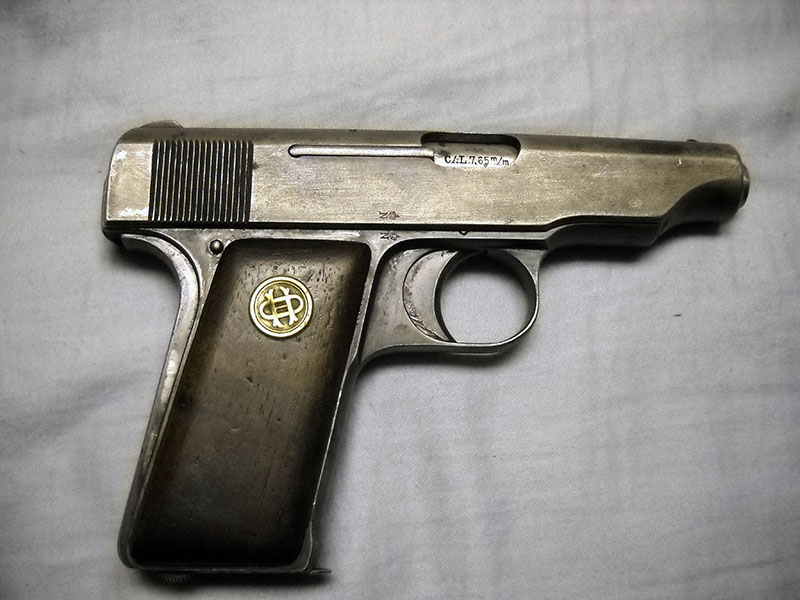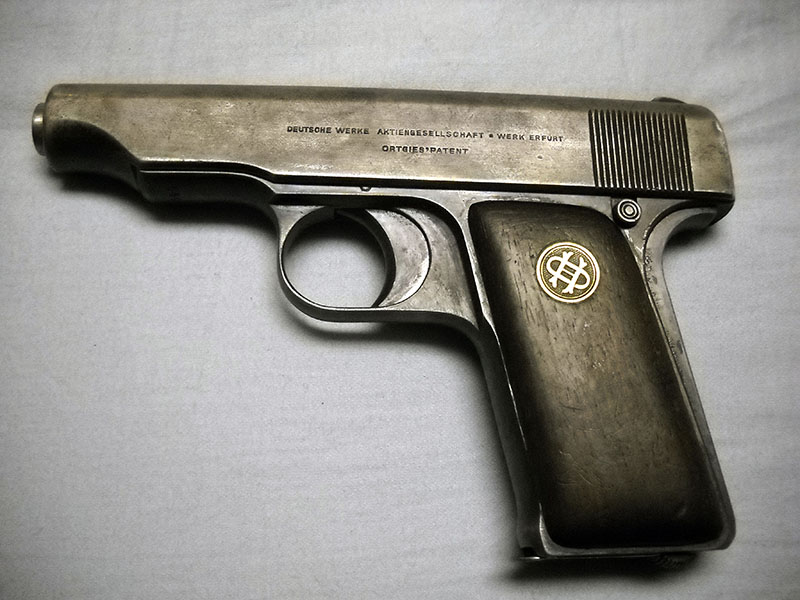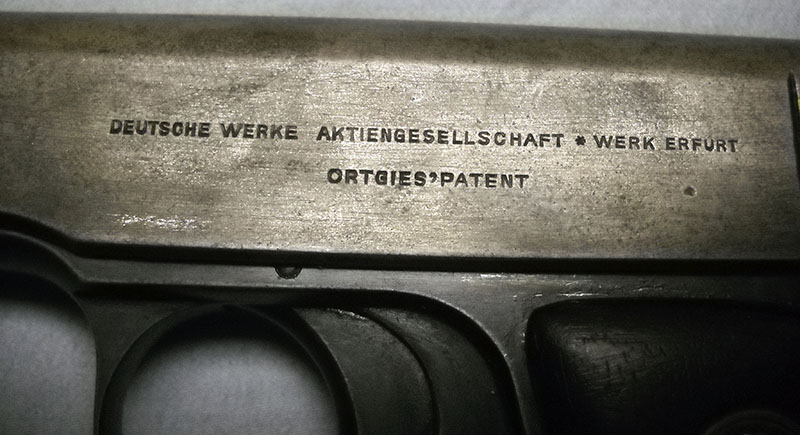

Originally posted February 29, 2016
It's a pretty short and photo-lite Gun of the Week this week, owing to the... unusual... circumstances prevailing at Eyrie HQ right now. Still, it's good to keep one's hand in on these things, and I do happen to have a few pics and some information about a slightly odd and interesting piece on hand (and a pretty special future installment up my sleeve for sometime hopefully fairly soon), so here is:

a .32-caliber Ortgies pistol, vintage, ehm... actually I'll have to get back to you on that for the exact year, my detailed notes on this one are in my other house. The Ortgies-patent pistols in general were made between the World Wars.
Like many handguns of the era (compare the Frommer Stop), the Ortgies is known by the name of its designer (or at least the owner of the patent on its design—more on this in a moment) rather than its manufacturer. In this case, the great bulk of the Ortgies pistols were made by Deutsche Werke, located in Erfurt, capital city of the state of Thuringia in central Germany. DW, not to be confused with the more famous DWM (Deutsche Waffen- und Munitionsfabrik, manufacturers of the Luger pistol among other things), was a state-owned arms factory until it was privatized as part of the demilitarization of Germany after World War I. In 1921, they bought up the small concern of Ortgies & Co., which manufactured a pocket pistol chambered for the ubiquitous 7.65mm Browning (.32 ACP) cartridge.
Ortgies & Co. was headed by one Heinrich Ortgies, who owned the patent on the pistol the company made. At least one source attributes the design to a German former employee of Fabrique Nationale in Belgium, one Karl August Brauning (not to be confused with John Moses Browning!), who sold the design to Ortgies. Why he wouldn't have sold it to FN is not made clear, although the same source notes that Brauning emigrated to the US between the wars; maybe he sold what became the Ortgies patent as part of his preparations for leaving Europe. At any rate, Ortgies had worked for unspecified arms companies in Liège, where FN was headquartered at the time, so that's probably how they met.
At any rate, DW bought out Ortgies and Co. in 1921, only a couple of years after production began, and with their greater resources they expanded the product line to include two other offerings: a new version of the original pistol in 9mm Kurz (.380 ACP) and a small-frame model in 6.35mm (.25 ACP). (Not that the "large-frame" pistol is all that large, really.) Unfortunately, the German economy was in the process of completely unraveling, and the pistols went out of production in 1923, at around the same time that the mark became essentially worthless.
The example shown, as you can see from the engraving on the chamber, is one of the 7.65mm/.32-caliber "original" models. This particular one is the first of three variations of the fifth variant of the gun's left-side markings.

The second version with this particular set of markings had a less elaborate version of the HO monogram medallion on the grips, while the third replaced it with a D-themed trademark for Deutsche Werke.
This is an odd little pistol. I mean, on the one hand, it's pretty straightforward; it has a simple blowback action and a single-column magazine with a heel release, which make it similar to a vast multitude of .32-caliber semiautomatic pistols available in that part of the world at around the same time. On the other hand, it has a deeply weird safety that is almost not a safety at all.
If you look at the photo of the left side above, you'll notice a little button above the grip. That looks like it might be a cross-bolt safety, which works a bit like those two-position switches you sometimes find in old lamps (push the rod so it sticks mostly out of one side to turn it on, push it back from the other end to turn it off). It isn't, though. Look at the right side and you'll see that there is no corresponding button there, just a little nub where the button on the left side is anchored.
What's really going on here is that the Ortgies has a grip safety—you can see the lever for it at the back of the grip, shown in the extended position in both photos—but it works backwards of the way grip safeties normally work. A normal grip safety is spring-loaded so that it's always on unless the shooter's hand depresses it by having a firm grip on the pistol; let go of the pistol and it comes on, which makes sense, since to most firearms designers the primary purpose of a grip safety is to help prevent a dropped pistol, or one the shooter doesn't have fully in hand yet (while being drawn from a holster, for instance), from firing at an unwanted moment.

The way the grip safety on the Ortgies works is that it's off when extended, as normal, but if you take a firm grip and depress it, it locks in place in the depressed, which is to say disengaged, position. The pistol is then live and ready to fire until it runs dry, is unloaded, or you press that little button, which disengages the latch and allows the grip safety lever to spring out to its "engaged" position again. That is completely weird by modern standards, and wasn't too far from it back in the 1920s.
Apart from that, there's nothing too unusual about the Ortgies. It doesn't stay open after the last shot, or if opened on an empty magazine, but lots of pistols of the era similarly lacked that feature. There's no way of holding it open on purpose either, which is where there are no photos of it here with the slide open. Disassembly is of the "be vigilant or you will shoot an important component across the room" school, which is, again, why you're not seeing any pictures of mine taken apart here.
The other striking thing about the .32-caliber Ortgies is that, like a good orange, it's surprisingly heavy for its size. Not massively so, but it gives an impression of compact solidity when held. The wooden grip panels are nicely made and very smooth; however the grip frame is quite short. It could really benefit from a magazine-mounted pinky rest, as are found on many Walther PPK magazines; without one, my pinky is completely uninvolved in holding the pistol, which is not really a problem but is a slight knock against it in the comfort department. Other than that, it's overall quite pleasant to hold. Shooting-wise, well, I haven't shot it, but it's an early-20th-century .32-caliber pocket pistol, so I'm pretty sure I know what to expect. (And it has the rudimentary sights one would expect of a firearm of its type and vintage, so it's probably not outstandingly accurate.)
--G.